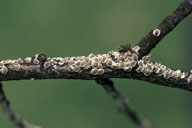European Elm Scale
Generations of European elm scale may spend more years with a tree on your property than you do. If left untreated, the tiny insects set up camp and spend their lives sucking a tree’s or shrub’s sap, removing the fluid that hydrates and delivers nutrients to all parts of it. Part of the aphid family, scales are tree infestation specialists. European elm scales focus on – you guessed it – elm trees.
European Elm Scale Description
Adult female European elm scales are about a third of an inch long and appear as a dark red, brown or purple oval with a soft but waxy fringe on the sides of the body.
The young nymphs, most commonly called crawlers, are yellow. The pests spend their lives in one place, hatching in late June and July 
European elm scales also have a unique characteristic that ensures their foothold on the evolutionary ladder: they can reproduce asexually. Under certain conditions – like extreme climate conditions, disruption of infestations – females can produce viable eggs without mating.
Yellowing, wilting leaves that coincide with the mating, egg-laying and hatching season are a sign of scale infestation. Look for the scales – crawlers on the underside, adult females in twig forks – or “honeydew” – a sticky substance produced from feeding – on twigs or branches. A dark, sooty mold often grows on the honeydew, causing the branch to turn black and die off. Although a scale infestation doesn’t automatically result in total destruction of a tree, the infestation can be unsightly.
SprayTech, Colorado tree health specialists, can help you identify European elm scale and determine a plan of action. Contact them at 720-248-0000 for more information.

